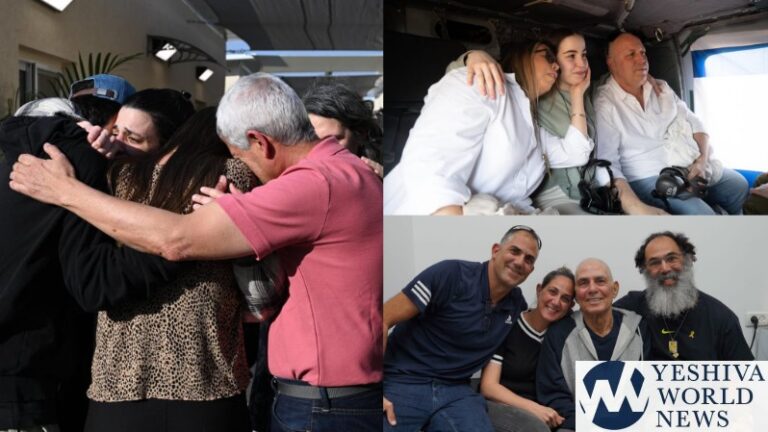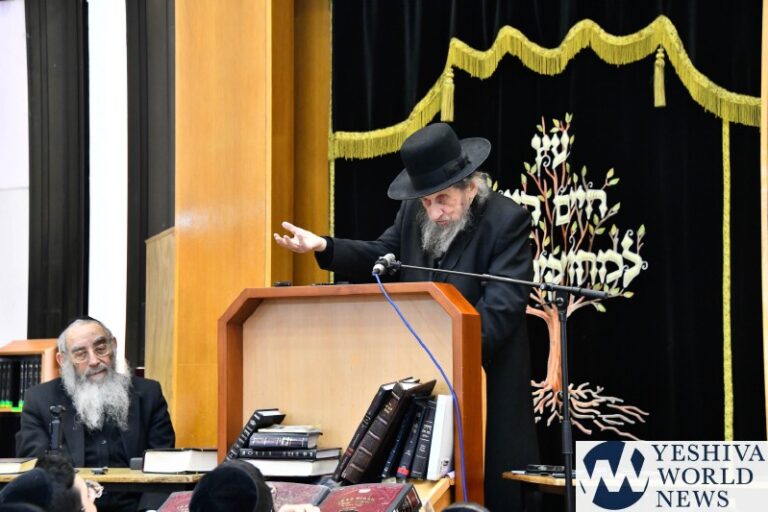V’asisa bigdei Kodesh l’Aharon achicha l’kavod ul’tifares (28:2)
Rav Yitzchok Hutner once related that while studying in the Slabodka yeshiva in Europe, he often heard America referred to as the “Goldeneh Medinah,” but living in the poverty that was rampant in Eastern Europe at that time, he couldn’t even begin to imagine the wealth and excess being referred to. Even upon arriving on America’s shores, he and all of the immigrants with whom he associated continued living under very simple and modest conditions. Hearing those around him complain about the difficulty involved in finding a job that paid a reasonable salary and allowed a person to observe his religious traditions, Rav Hutner remained cynical about the reports that America was a country where money was the most precious commodity and dollars rolled down the streets.
One day that all changed. It was the week of Parshas Tetzaveh. Rav Hutner was walking outside when he observed two young Jewish boys playing ball in front of their house. The older of the two was regaling his younger brother with all that he had learned in yeshiva about the lofty position of the Kohen Gadol: his special garments designed to invoke glory and splendor, the offerings he was able to bring daily in the Beis HaMikdash, and his unique role in effecting atonement for the entire nation on an annual basis. The younger boy listened with interest and fascination, envisioning the action transpiring before his very eyes. He paused to take it all in and digest it before asking, “Tell me, how much was his annual salary?” Sadly, Rav Hutner realized that he had finally been welcomed to the Goldeneh Medinah, where the emphasis on the pursuit of the mighty dollar takes precedence over spiritual goals and aspirations.
Va’ta’as ha’ra b’einei Hashem (Shmuel 1 15:19 – Haftorah)
The Haftorah for Parshas Zachor records Shmuel’s instructions to Shaul to kill all of the Amalekites and their animals. When Shaul did not follow orders, Shmuel came to rebuke him and informed him that he had done evil in the eyes of Hashem. The Chofetz Chaim points out that Shaul’s primary sin was seemingly passive in nature, meaning that he was commanded to fulfill the Biblical commandment of destroying Amalek, and he neglected to do so when he decided not to kill Agag and some of the animals. If so, Shmuel’s word choice seems inaccurate, as he said that Shaul’s sin was actively doing something evil in the eyes of Hashem.
The Chofetz Chaim explains that Shaul was commanded to kill all of the Amalekites, and if he had followed Shmuel’s instructions and done so, it would have been considered a mitzvah. However, since he did not adhere to Shmuel’s orders, he demonstrated that everything he had done was not to fulfill Hashem’s command, because if that was his motivation he would have killed all of them. Therefore, now that Shaul wasn’t acting to fulfill the mitzvah, he was considered guilty of murder for every Amalekite who was killed, and these countless acts of murder were the active sin to which Shmuel was referring when he said that Shaul had done evil in Hashem’s eyes.
V’ha’na’arah yefas to’ar v’tovas mareh (Esther 2:7)
The Gemora in Megillah (13a) quotes the opinion of Rav Yehoshua ben Karcha, who maintains that Esther was not inherently beautiful. In fact, she was a yerakrokes – she had a green complexion – but Hashem miraculously caused to find favor in the eyes of everybody who saw her. The Gemora does not provide a source for Rav Yehoshua ben Karcha’s opinion, and it seems difficult to understand. If the Megillah explicitly testifies that Esther was physically attractive, for what reason did he denigrate her?
The Vilna Gaon explains that specifically Rav Yehoshua ben Karcha had no choice but to reinterpret the Megillah’s statement about Esther’s appearance. The Gemora in Bava Basra (15b) records a dispute regarding when Iyov lived, and it quotes several opinions. One of them is that of Rav Yehoshua ben Karcha, who maintains that he lived in the times of Achashverosh. His source for this is a verse in Iyov (42:15) which states V’lo nimtza nashim yafos kib’nos Iyov b’chol ha’aretz – Iyov’s daughters were the most beautiful women in the world. When was there a time in world history that the entire world was searched and examined for beautiful women? In the times of Achashverosh.
However, this explanation presented Rav Yehoshua ben Karcha with a difficulty. If Achashverosh set up a royal beauty pageant to seek out the most beautiful woman to be his wife, why didn’t he choose one of Iyov’s daughters if the verse testifies that they were the most attractive women in the world at that time, and why did he choose Esther if she was less beautiful? In order to resolve this question, Rav Yehoshua ben Karcha concluded that Esther’s selection had nothing to do with her true appearance, as she was in fact naturally unattractive, but Hashem miraculously caused her to find favor in the eyes of everyone who saw her, which caused Achashverosh to select her over Iyov’s daughters.
Vayomer Haman af lo heivi’ah (5:12)
The Medrash teaches that there were four individuals who began speaking using the word “af,” and each of them was punished and destroyed. The serpent said to Chava (Bereishis 3:1) Af ki amar Elokim lo soch’lu mikol eitz ha’gan – Did Hashem perhaps say that you may not eat from any of the trees in the garden. Pharaoh’s chief baker said to Yosef (Bereishis 40:16) Af ani ba’chalomi v’hinei shlosha salei chori al roshi – I also (had a dream); in my dream, behold, three wicker baskets were on my head. Korach’s followers said to Moshe (Bamidbar 16:14) Af lo el eretz zavas chalav u’devash heviosanu – Moreover, you didn’t bring us to a land flowing with milk and honey. Finally, Haman told Zeresh and his friends Af lo heivi’ah – Moreover, Queen Esther brought nobody (to her royal banquet other than me).
When our Sages group multiple episodes together to point out that they are similar, they are not merely making a superficial observation, such as the fact that these individuals began their sentences with the same word. There must be some deeper common thread. In this case, the Kli Yakar explains that each of them sinned as a result of strong feelings of kinah – jealousy.
The serpent was jealous of Chava, the baker was envious of the positive interpretation that Yosef provided the cupbearer for his dream, Korach’s followers coveted the leadership of Moshe and Aharon, and Haman was jealous of Mordechai’s refusal to bow down to him. The Kli Yakar adds that this explanation is beautifully alluded to by the fact that the letters in the word kinah stand for Korach, nachash (serpent), ofeh (baker), and Haman.
Aseres b’nei Haman (9:10)
When the person reading the Megillah gets up to the names of Haman’s ten sons who were hanged, he pauses while the congregation reads them quickly before he reads them out loud. The Rogatchover Gaon gives a brilliant explanation for this custom. Even though most people don’t read the Megillah, they fulfill their obligation to hear it through the concept of shomei’ah k’oneh, which means that somebody who listens to something is considered to have said it himself.
However, while this principle works for fulfilling our primary obligation to read the Megillah, in this case, there’s a problem. The Gemora (Megillah 16b) teaches that there is an obligation to read the names of Haman’s ten sons in one breath to commemorate the fact that they all took their last breaths together at the same time. Ideally, we would say all of their names simultaneously, but since that isn’t humanly possible, we read them quickly in one breath.
The Rogatchover explains that although the rule of shomei’ah k’oneh makes it legally considered that the listener said something himself, it’s not enough to make it viewed as if he said it in one breath, which leaves the listener no choice but to say the names of Haman’s ten sons himself in one breath, as that requirement cannot be fulfilled by listening to somebody else do it.
V’hayamim ha’eileh nizkarim v’na’asim b’chol dor va’dor (9:28)
The Mishnah in Megillah (17a) rules that a person who reads the Megillah backward does not fulfill his obligation. The Ostrovtzer Rebbe questions why a person would ever consider reading the Megillah backward. He suggests that although most of us are familiar with the plot of the storyline from a young age, somebody who is encountering the narrative for the first time may quickly become frightened by the rise to power of the inimical Haman and his diabolical scheme to exterminate the Jews.
Such a person may quickly flip a few pages to see if the story, as Hollywood has taught us to expect, ends happily ever after. Upon discovering that the Jews were indeed saved, Haman and his sons were hanged, and Mordechai and Esther inherited Haman’s estate, he then turns back to the beginning to continue with the narrative to discover how the suspenseful plot unfolds.
Every person’s life is full of struggles and challenges. The lesson of the Megillah is that a Jew must face them with a deeply-rooted conviction that an all-powerful and loving Hashem is watching over him and will orchestrate the unfolding events in a way which is for his ultimate good. The Ostrovtzer Rebbe writes that the Mishnah is hinting that a person who reads the Megillah “backward,” only willing to relive the difficult and frightening events after he is already assured of the happy ending, has missed the point entirely and therefore failed to fulfill his Purim obligation.
L’kayem es y’mei haPurim ha’eileh bizmaneihem (9:31)
The Megillah records that Esther and Mordechai instructed the Jews of their generation to establish the observance of the days of Purim in their proper times. The Gemora in Megillah (2a) derives from the plural reference to “times” of celebration that the day on which walled cities observe their Purim festivities (15 Adar) must differ from the day on which unwalled cities do so (14 Adar).
Rav Zev Leff notes that Purim is known as the Yom Tov of achdus (unity), as we focus on joining together to hear the Megillah and eat the festive Purim meal, sending packages of food to friends and family, and remembering to help our poor brethren so that they may also enjoy their meals. If so, wouldn’t it have made for more of a sense of community for the Sages to insist that all Jews should specifically observe Purim together at the same time?
Rav Leff answers that if everybody is acting in the exact same manner at precisely the same time in an identical fashion, this can hardly be called true togetherness. The reason they would feel united wouldn’t be because of any genuine, deep-rooted sense of identification with other Jews, but merely because they all happen to be doing the same thing at the moment.
True achdus is when one Jew is able to tolerate and accept that another Jew is conducting himself differently than he is, and to nevertheless recognize that each in his own unique way is equally fulfilling the will of Hashem. The Sages further obligated us to send Mishloach Manos, which represent the concept that one Jew sends food from his personal kitchen, prepared according to his customs and preferences, to his friend, who in a demonstration of genuine unity happily partakes of it. In order to teach us this lesson about the definition of authentic achdus, Esther and Mordechai specifically mandated that Purim be observed on different days.
Answers to the weekly Points to Ponder are now available!
To receive the full version with answers email the author at [email protected].
Parsha Points to Ponder (and sources which discuss them):
1) If female Kohanim would be permitted to serve in the Beis HaMikdash, would they be allowed to wear the garments of the Kohanim, or would doing so violate the prohibition (Devorim 22:5) against wearing men’s clothing? (Gilyonei HaShas and Ha’aros Al Kiddushin 36b)
2) Of all of the items that Hashem created during twilight on Erev Shabbos at the end of the week of Creation, which of them was needed for the garments of the Kohanim? (Avos 5:6, Sotah 48b)
3) Rashi writes (Devorim 25:19) that in order to completely blot out the memory of Amalek, we must also destroy the possessions of the Amalekites so that their name shouldn’t be mentioned in conjunction with them. How was Esther permitted to accept the house of Haman (Esther 8:1), who was descended from Amalek? (Shu”t Oneg Yom Tov Introduction, Shem MiShmuel Purim, Imrei Emes, Nesivos Rabboseinu, Taima D’Kra Esther, Ma’adanei Asher 5769)
4) If Purim falls on Motzei Shabbos, may one practice reading the Megillah on Shabbos, or is this forbidden as an act of preparation for after Shabbos? (Shemiras Shabbos K’Hilchaso 28:fn169)
© 2012 by Oizer Alport.










